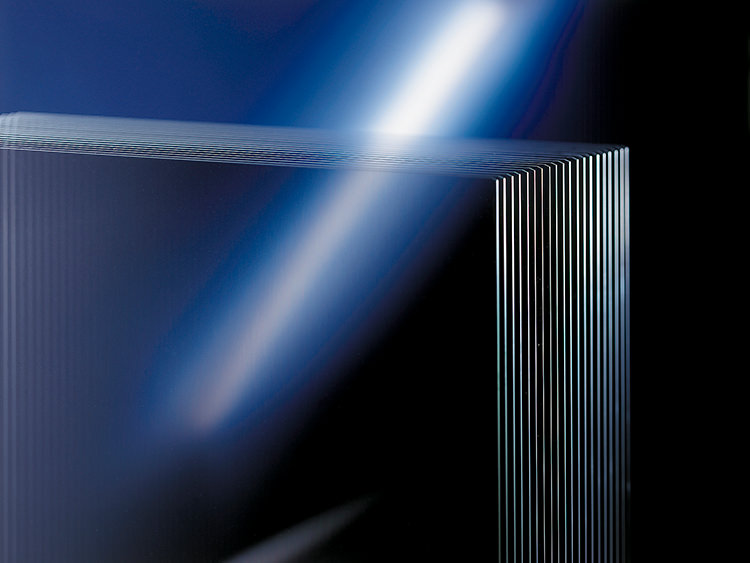For its transparency, flat and smooth surface, and excellent heat resistance, this product is used as a substrate for various types of displays such as televisions, personal computers, smart phones, tablet devices, and in-vehicle infotainment. It is an alkali-free aluminosilicate glass that was developed by using the float process.
Applications
- Glass Substrates for TFT-LCD Displays
- Glass Substrates for OLED Displays
TFT-LCD glass meeting strict quality requirements
Recently, screen sizes of LCD TVs have become wider and larger. The glass substrates from AGC enable this trend of larger LCD TV sizes. Glass substrates also play a key role to reproduce clear and beautiful screen images as one of the core components of LCDs.
It is necessary for TFT-LCD glass to meet many strict quality requirements. Unlike window pane glass, glass for TFT-LCDs is not allowed to contain alkalis. This is because alkali-ions contaminate liquid crystal materials and even adversely affect the characteristics of the TFT. Additionally, the glass should not exhibit large sagging even though its thickness is just 0.3 to 0.7 mm and should have excellent heat resistance while assuring dimensional stability even after being heated at high temperature. The glass also should have properties that its composition does not dissolve during the fabrication process using chemicals. "AN100", non-alkali glass developed by us, is the one that has fulfilled those various requirements. Furthermore, since "AN100" does not contain hazardous materials such as arsenic or antimony, it has high reputation for being an environment-friendly glass. Our technologies are supporting the design of thin, large, and environmentally friendly LCD TVs.
Core technologies to enable clear and vivid screen images
An LCD has a layer of liquid crystal sandwiched between two sheets of glass. The most remarkable feature of liquid crystal is its optical characteristics of being both a liquid and a solid. Applying voltage to the layer of liquid crystal causes the orientation of the molecules in the liquid crystal to change relative to each other. This molecule rearrangement controls the light transmission from the backlight; the light passes through color filters of red, blue, and green, and eventually rich images appear on the screen.
Majority of LCDs in wide use now are TFT-LCDs. In a TFT-LCD, a layer of thin film that forms transistors is used as a device that applies voltage to the liquid crystal layer, and those transistors control the voltage supplied to each pixel. The advantages of a TFT-LCD are high resolution and quick response time that enables motion image to be fine and clear.
Recently, displays with higher resolution such as 4K and 8K are being developed one after another and have made it possible for viewers to enjoy vivid and fine picture even in very large screen sizes.
It is AGC’s display glass substrates, developed using its distinctive precision glass processing technologies, that support these higher resolution TVs.
LCD Displays play important roles in a number of different ways in our daily life
Smartphones and tablets can now be considered life necessities, and the LCD screen is the most frequently used interface whenever such devices are used. Without the LCD display, it is not possible to send email or view pictures taken by the camera function.
Furthermore, LCDs play an important role in a variety of applications such as in-vehicle displays, e.g. navigation systems and center information displays, and digital signage.
Through production and supply of LCD glass substrates, which is a key material of LCDs, AGC helps create a more convenient and comfortable life through integrating various technologies within the Group.


